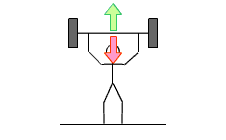The green arrow shows the force on the weights as the weightlifter pushes upwards.
The red arrow shows the downwards force on the weightlifter’s arm muscles.
These two forces are an interaction pair. They are equal in size, and opposite in direction.
You only have an interaction pair if the forces are caused by the interaction. In this case, the compression in the weightlifter’s muscles is caused by the weight pushing down, and the upwards force on the weight is caused by the weightlifter’s muscles.

Comments
No comments have yet been made